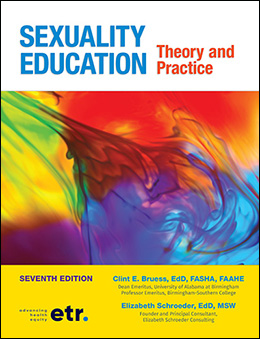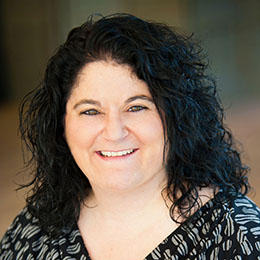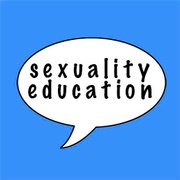What Are The Goals of Sexuality Education? Probably Not What You Think
By Clint Bruess, EdD and Elizabeth Schroeder, EdD, MSW | March 19, 2019
Dean Emeritus, University of Alabama at Birmingham (CB) and Sexuality Educator, Trainer and Consultant, Elizabeth Schroeder Consulting (ES)
Although sexuality education has changed significantly since the early 20th century, many of the goals still focus primarily on public health outcomes. Federal and state-level funding streams tend to focus, for example, on reducing unplanned pregnancy and avoiding STIs.
Now, don’t get us wrong—these are important parts of many sexuality education programs. If these are the only goals, however, they exclude other vital parts of who we are as human beings. They also connect human sexual experience exclusively to negative health outcomes. Doing so significantly contributes to the shame, fear and stigma surrounding human sexuality for far too many.
Sexuality Education: Theory and Practice, Seventh Edition
 Clint E. Bruess, EdD, FASHA, FAAHE, and Elizabeth Schroeder, EdD, MSW. Sexuality Education: Theory and Practice (Seventh Edition). Scotts Valley CA: ETR, 2018.
Clint E. Bruess, EdD, FASHA, FAAHE, and Elizabeth Schroeder, EdD, MSW. Sexuality Education: Theory and Practice (Seventh Edition). Scotts Valley CA: ETR, 2018.
ETR is proud to offer this new edition of an outstanding standard in the field. The text is a useful resource for new students in the sexuality education field as well as for seasoned professionals seeking current information and updates on successful teaching methods. Highly recommended by an impressive group of researchers and educators. Learn more here.
Celebrate Being Human
If we wish to truly support the development of sexually healthy young people and adults, we need to teach about sexuality in ways that celebrate the vast range of human feelings and experiences. We need to stop trying to frighten people out of exploring their normal, natural feelings and instead teach them about the positive aspects of human sexuality. We can do this and still make room for discussing potential negative aspects and the importance of considering the outcomes of our actions.
For example, some schools still show students photographs of STI-infected genitals in an effort to scare students out of wanting to have sex. This is problematic for numerous reasons. First, the photos tend to show late-stage, untreated STIs, which is not typically what a young person would see if they were in a sexual relationship with another person. Considering the most common symptom of an STI is no symptom, showing these slides spreads misinformation. Second, fear is not an appropriate teaching method in sexuality education, especially when it is not coupled with information and skills for students to build self-efficacy in what they can do to avoid or manage STIs.
A conversation with Elizabeth Schroeder: Fear-based approaches
 I used to teach a course called The Teaching of Health. In the course, we talked about the extensive research showing that fear was not an effective motivator for behavior change. Disequilibration, or even some unease, is part of both the Transtheoretical Model and the Health Belief Model (that is, “Do I think the negative health outcome will happen to me? Do I think it will be bad enough that I should do something about it?”).
I used to teach a course called The Teaching of Health. In the course, we talked about the extensive research showing that fear was not an effective motivator for behavior change. Disequilibration, or even some unease, is part of both the Transtheoretical Model and the Health Belief Model (that is, “Do I think the negative health outcome will happen to me? Do I think it will be bad enough that I should do something about it?”).
But those questions are different from scaring the kahooey out of someone and expecting that to result in behavior change. In fact, some folks–especially adolescents–will intentionally dig in their heels in the face of fear to prove they are invincible and that adults are wrong.
So the main thing is, fear alone doesn’t motivate behavior change, whether that has to do with sexual health or any other kind of health. And when there’s too much of it, or educators go over the top to make something sound scary, it can have deleterious effects on the individuals, whether youth or adult.
Put Decision-Making Skills Forward
Instead, we should be spending time teaching decision-making skills. Both youth and adults need to know about the potential outcomes, positive and negative, of shared sexual behaviors. They need opportunities to reflect on how they might respond if they were to experience any of those.
We should build self-efficacy by teaching skills young people will need well into their adult lives, such as open communication and negotiation skills, and how to ensure consent is clearly given and received as part of their relationships.
A number of sexual health education entities around the world have posited their thoughts about what the overall goals of sexuality education should be. According to UNESCO (2018):
The goals of comprehensive sexuality education are to equip [people] with knowledge, skills, attitudes and values that will empower them to:
- realize their health, well-being and dignity
- develop respectful social and sexual relationships
- consider how their choices affect their own well-being and that of others
- understand and ensure the protection of their rights throughout their lives
Look at Deeper Implications
These goals may seem fairly straightforward, but there are deeper implications within each:
- Realizing health, well-being and dignity includes not only our own health, well-being and dignity, but that of others. It means understanding and honoring the range of life experiences, desires and identities that exist in the world, even when they are different from our own.
- Developing respectful social and sexual relationships refers to the many factors and decisions relating to being in relationship with others: friendships, love relationships and/or sexual relationships. It includes understanding that people may choose to be in relationships, or choose not to be. They may be in relationships with more than one person at a time. Relationships can look dramatically different from one to another. It includes understanding that some people will have feelings of attraction for one gender or more than one gender; or to people who have certain physical, emotional and/or intellectual traits; or, sometimes, to no one at all. All of these need to be acknowledged as equally valid human experiences, again, even when they are different from one’s own.
- Considering how their choices affect their own well-being and that of others reinforces that how we interact with others can have powerful, long-lasting impacts for everyone involved. This is where lessons come in relating to respect, giving and receiving consent, avoiding pressure and coercion and getting help if one thinks one is being pressured or coerced.
- Understanding and ensuring the protection of their rights throughout their lives frames human sexuality as far more than a course topic or something to be googled online. This powerful goal asserts that we all, regardless of age, have the right to understand what is happening with our bodies and in the world around us. It admonishes adults that withholding this information, or, even worse, misinforming young people about sexuality is harmful and dangerous. It states unapologetically that all people—of all races, ethnicities, cultures, physical and intellectual abilities, genders, sexual orientations, educational and socioeconomic levels—all people have the right to be treated with dignity and respect, and the responsibility to treat others with the same.
Just as “sexuality” is about far more than sexual anatomy and behaviors, the goals of sexuality education must reflect more than the possible outcomes of shared sexual behaviors. They must teach young people and adults information and skills that contribute to the very fabric of the world in which we all live.
Clint E. Bruess, EdD, is Dean Emeritus, University of Alabama at Birmingham and Professor Emeritus, Birmingham-Southern College. He is a longtime teacher of graduate and undergraduate courses in sexuality education and in human sexuality. He can be reached at cbruess@bsc.edu.
Elizabeth Schroeder, EdD, MSW, is an international sexuality education and youth development expert. See her website here. She can be reached at info@drschroe.com.





